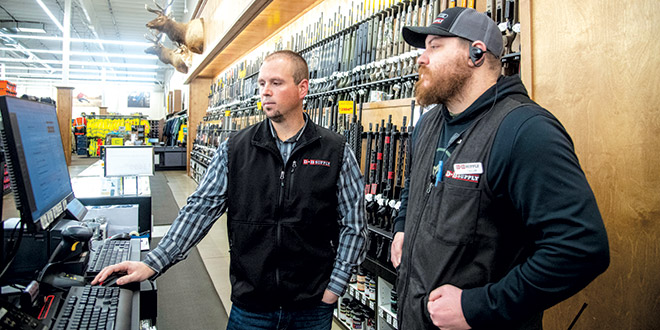On any given day, we have a plethora of ways—from face-to-face to FaceTime, phone calls to text messages, digital to analog—to communicate with one another. No matter what method you choose, it is frustrating when messages get lost or ignored and communication breaks down, which makes it important to choose the right channel.
When it comes to communication in the workplace, the same holds true. There are a lot of options for employees to communicate with one another, and choosing the right one can mean the difference between clear communication and misunderstandings among your staff.
According to the Communication in the Workplace Statistics 2024 report from Pumble, a communication platform, 86% of employees and executives cite the lack of effective collaboration and communication as the main causes of workplace failures. Nearly 70% of employees believe that wasted time is one of the worst consequences of poor communication.
As you consider your workplace communication challenges, these two retailers share the tools they have implemented to address their own obstacles.
Improving Communication Flow
When Kevin Lundergan started working for D&B Supply as a teenager, he didn’t realize he was beginning his career in the independent home improvement industry. Lundergan wanted to be a police officer and attended college to pursue this dream while still working part-time with D&B Supply, which has 15 locations in Idaho and Oregon. During this time, he was offered an assistant manager position with another D&B Supply location. He took it and never looked back. Lundergan moved into several manager roles, and now 20 years later, he serves as the director of operations for D&B Supply.
That extensive experience in a number of locations, combined with the variety of roles he’s held, has given Lundergan a unique perspective when it comes to company communications, which Lundergan addressed in his business improvement project he completed as part of the North American Hardware and Paint Association’s (NHPA) Retail Management Certification Program.
Addressing Growing Pains
During his business improvement project, Lundergan looked at the way D&B Supply employees at all levels were communicating and the challenges the operation faced when it came to communications.
“We have grown so fast in the last few years and were always accustomed to the old school ways of doing things,” Lundergan says. “During the Retail Management Certification Program, I wanted to pinpoint those challenges and then find solutions to overcome them.”
One big challenge was follow-up, as management didn’t have an effective way to track tasks sent out to the employees in each of the stores.
“We were always constantly getting on the phone or sending an email to follow up,” Lundergan says.
Leadership at D&B Supply was using six different methods to communicate with employees, which made it difficult to track, follow-up and engage. At D&B Supply, every employee has access to anyone else in the company via email, which Lundergan says is great to create a culture of openness, but having to constantly answer different emails takes time away from other tasks.
Managers also didn’t have an effective way to know whether employees were getting the information sent out to them. Lundergan says managers were unable to track how many employees were reading the newsletters, and while they could see who had logged into email, they weren’t able to effectively track what was getting done.
A Comprehensive Solution
As he worked on his business improvement project, Lundergan discovered Zipline, a task management platform, and saw how it could improve communications at D&B Supply. It wouldn’t be an easy sell, however.
“Moving to Zipline ended up being a bit of a culture shock, not just because we had never really had a task management program before, but because it has essentially changed the way we communicate as far as the flow from the stores to headquarters, from management to their employees,” Lundergan says.
With Zipline, employees can access everything on one system. Many of the company’s documents that are employee-facing live in Zipline and the learning management system (LMS) is tied into the platform as well, allowing employees to log into one platform to access all their training. The platform also houses all safety documents and audits.
Lundergan says Zipline’s search functions make it easy to find and access any of the documents in the platform and he can label documents with different tags such as “marketing” or “operations” for even easier organization.
“All of that time adds up when you’re not having to search for documents and can access everything in one place,” Lundergan says. “We’ve seen an improvement in employee engagement and more engagement in training. And when our employees are better trained, it leads to less turnover.”
Because everything is in one location, the flow of communication is streamlined. Information from the main office gets to the stores quicker and vice versa. The platform also has a messaging feature that simplifies how employees connect with one another.
“With email, you’re looking at all these reply-all messages and you’re trying to count which stores have responded and which stores haven’t,” Lundergan says. “Zipline shows who has responded, who has opened and who’s in the middle of doing a task.”
Managers can assign tasks to employees directly through the system, and when an employee completes that task, they check it off and the manager can see it was completed.
“Because we aren’t always able to do employee huddles at every shift, Zipline has allowed the managers to put together a list that’s ready for the employee when their shift starts; each employee knows exactly what they need to do,” Lundergan says. “Each manager can see in real time who checked in so they can better manage their employees.”
D&B Supply employees utilize hand-held communications devices in the store and the Zipline app is included on each of those so employees can take advantage of the platform’s real-time features. Zipline can also be accessed from company desktops and workstations throughout the stores.
The positive impacts have gone beyond antidotes as well. Lundergan says so far, the company has been able to eliminate over 550 company emails, saving over $87,000 a year. Lundergan estimates that the time savings will add up to over 40 hours a week across all locations.
“We want to move all those saved hours into offering better customer service,” he says. “We also want to concentrate more on merchandising, price integrity, out of stocks, training and other areas of the store.”
Offering a Variety of Solutions
For Koopman Lumber, which has 12 locations in Massachusetts, keeping communications straight from employee to employee and store to store can get complicated. Vice president of branch operations and retail sales Matt Nichols says the company doesn’t rely on just one communication platform, but has implemented several, each serving a specific purpose.
Microsoft Teams has been an effective solution for communicating across locations as employees are always available via the Teams chat feature. Because Teams also syncs with employees’ calendars, everyone can see if an employee is in a meeting or unavailable. Teams is also used for any virtual video meetings.
Messaging is also done through the company’s payroll system. Koopman Lumber human resources employees use the company’s payroll system to send messages to all employees—even employees who might not have a Koopman Lumber email address—regarding important human resources information such as insurance policies or open enrollments.
Another impactful communication tool that also benefits project and work management that Koopman Lumber utilizes is Asana, a platform to organize, track and manage work flows. Nichols says employees have been using Asana since 2015, and the company currently has over 50 users coordinating and collaborating on projects.
“I can see upcoming due dates for my team and what they might be behind on or need some help with,” Nichols says. “It also has a number of automation features that allow us to quickly check the status of any project.”
Asana has helped with store-to-store communication, as each of the stores has its own board within Asana. Employees of each store post tasks or information other employees of that store need to know, such as merchandising tasks that need to be completed. Each store can also share information to the other stores.
“An employee can post a picture of an endcap that’s been done in one location, and then other locations can duplicate that endcap,” Nichols says.
Asana offers integrations with Teams and the Koopman Lumber portal as well, expanding the usefulness of the tool. Any conversations in Teams or forms submitted through the employee portal can be converted to a task in Asana.
Remedying safety issues is another big way Koopman Lumber employees use Asana.
“If our safety manager, regional managers or store managers find something that may be a safety issue, they can take a picture and just email it directly to the Asana board,” Nichols says. “Then the employee who completes the task can attach a photo showing how they rectified the safety issue, and everyone can learn from the experience.”
Every quarter, Koopman Lumber employees receive the “Koopman Quarterly” employee newsletter. Nichols says the newsletters include a note from the owners, information on focuses for the upcoming quarter, an employee spotlight and other fun content like recipes. The newsletter is sent via HubSpot, which provides analytics and information on how employees are engaging with it.
“The newsletter has been a great tool for us to get the word out about the different events we have going on,” Nichols says.
Koopman Lumber also uses EZ-AD TV, which is an easy-to-manage platform where monitors are mounted in the break rooms around the company. The monitors share company information, events, job postings and more.
“That platform is new to us, but it’s already made a positive difference on how well the information is getting communicated,” Nichols says.
Nichols and other leaders at Koopman Lumber leadership understand that employees don’t digest information the same way and have tailored their communications strategy to accommodate employees by offering a variety of channels and methods. They also continually evaluate the effectiveness of each channel to evolve as needed.
“Our philosophy is the more communication, the better,” Nichols says. “If we can put that information out there for our employees in different ways, they are more likely to engage with it.”
Implementing Intentional Internal Communications
By Adam Gunnett
In hardware retail, effective employee communication is essential for smooth operations and a positive workplace culture. Utilizing intent-based communication mapping allows managers to categorize information by importance and urgency, ensuring the right message is delivered through the most appropriate channel. Here’s how to apply this approach in your store:
Need-to-know information includes time-sensitive, actionable tasks. In home improvement retail, this could involve inventory counts, daily sales targets or restocking schedules. Since this information directly impacts daily operations, it should be communicated quickly and clearly. Delivery mechanisms like task management systems or in-person huddles are ideal for these urgent messages. It’s crucial that employees understand the urgency and know exactly what action is needed to keep operations on track.
Evergreen information is long-term and foundational. This includes employee handbooks, company policies, seasonal product training guides and safety procedures. While not immediately actionable, this information is vital for the store’s overall success. Keeping this information easily accessible, such as in a shared online library or a physical binder in the break room, allows employees to reference it when needed without being overwhelmed by constant reminders.
Managers should ensure this information is periodically updated, particularly as new products or seasonal changes occur. For example, before a major sale season, reviewing promotional guidelines with
employees can help prevent confusion and ensure consistent customer service.
Dialogue and discussion is about fostering collaboration and idea-sharing among employees. This could include brainstorming ways to improve store layout, product displays or promotion ideas. Informal channels like team meetings, group chats or suggestion boxes are great ways to encourage this type of communication. By using these less formal methods, managers can create an open environment where employees feel comfortable contributing ideas.
Nice-to-know information focuses on building morale and strengthening the team’s connection to the business. This could include congratulatory notes for reaching sales goals, recognition of excellent customer service or acknowledging work anniversaries and birthdays. For this type of communication, delivery mechanisms like bulletin boards, social media or companywide emails work well to spread positivity and build a sense of community.
By using intent-based communication mapping, home improvement retailers can tailor their communications to the situation and choose the most effective delivery channel. This structured approach ensures that critical tasks are addressed promptly, long-term information is always available, collaboration is encouraged and morale is boosted—creating a more engaged and effective team.
“By using intent-based communication mapping, home improvement retailers can tailor their communications to the situation and choose the most effective delivery channel.”
Choosing the Right Channel
Not only do you need to choose the right channels for communication, you need to be willing to evolve or change if that channel stops being effective.
For Franklin Cloninger, general manager at Triangle True Value Hardware in Greenwood, South Carolina, the problem hasn’t been overcommunication, but communicating in the wrong way.
Cloninger says they ask every potential employee during the interview process how they prefer to communicate and for a long time, the answer has consistently been text messaging.
“It has now shifted, especially with some of our younger employees, that in-person is the most desired way to communicate,” Cloninger says.
Cloninger had to re-evaluate what had been working for him in terms of communication. He is currently using the Homebase app, which provides a way to send frequent messages to everyone on staff. The app also shows who opened the message and who didn’t, so individual follow-ups can happen as needed.
“We are finding that because people are being notified so much, those messages are getting lost or just not read,” Cloninger says.
Based on the feedback from employees and input from interviewees, Cloninger says he plans on moving to more in-person communication, and he will continue evaluating what is working and what isn’t.
“It’s coming full circle, and we’re coming back to having more direct communication,” he says. “We want it to be casual and more in the moment while still remaining intentional.”
 Hardware Retailing The Industry's Source for Insights and Information
Hardware Retailing The Industry's Source for Insights and Information







